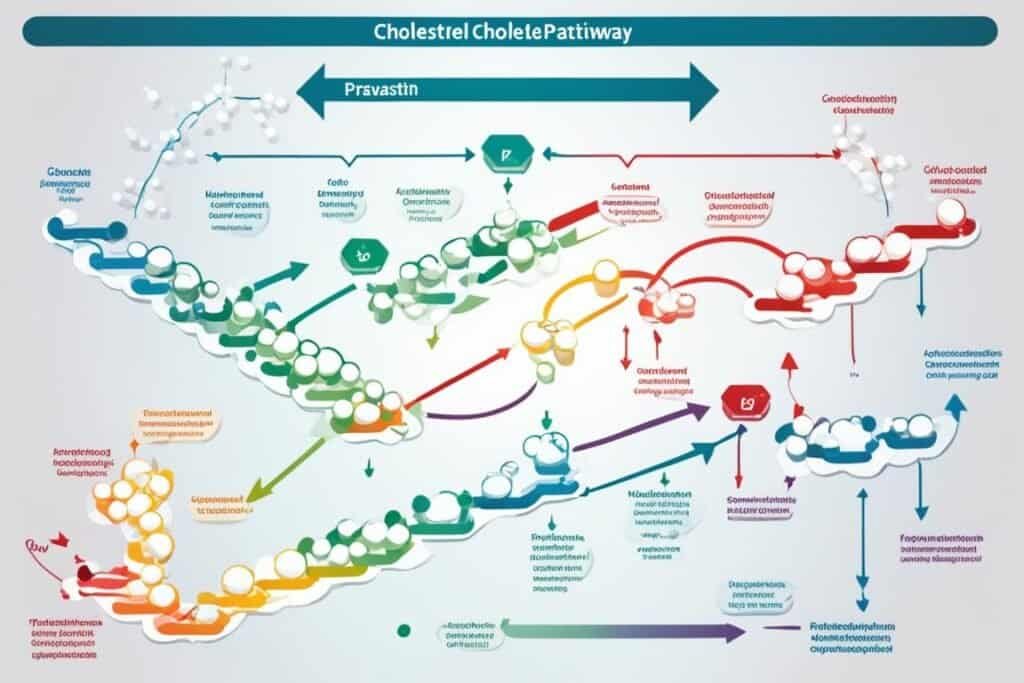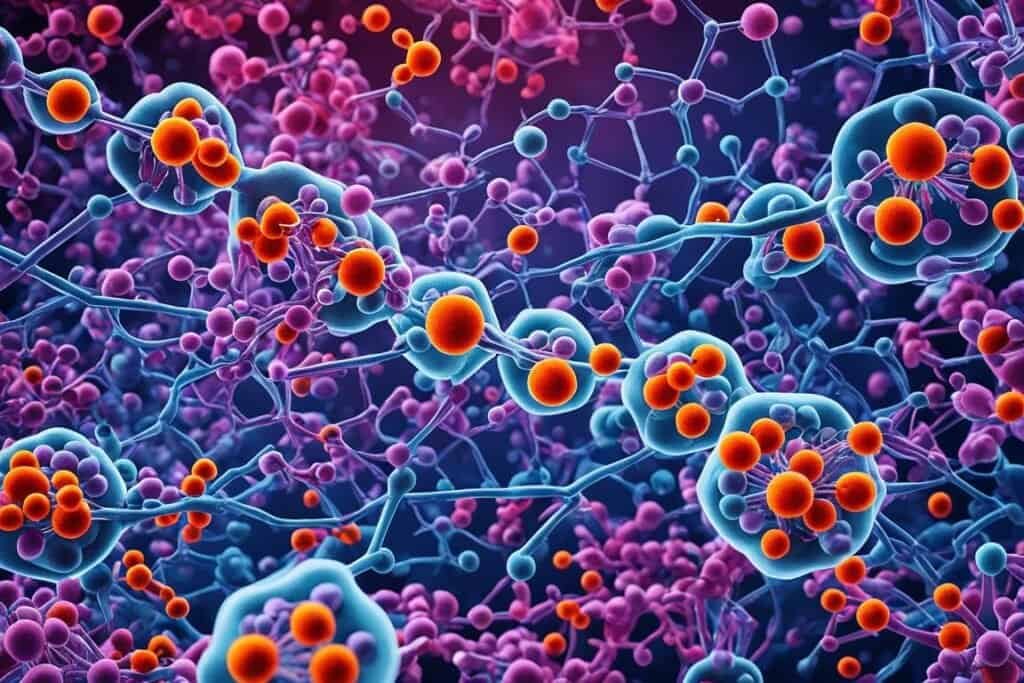Welcome to our guide on the reducing agent required for cholesterol biosynthesis! If you’re looking for ways to control your cholesterol levels, understanding the role of reducing agents in cholesterol synthesis is essential. We’ll dive into the details of pravastatin, a widely used cholesterol reducing agent that can help you manage your cholesterol levels effectively.
Key Takeaways
- Pravastatin is a statin medication used as a reducing agent for cholesterol synthesis.
- It competitively inhibits HMG CoA reductase, the enzyme responsible for cholesterol production.
- Pravastatin is primarily used to treat hypercholesterolemia and reduce the risk of cardiovascular events.
- Side effects of pravastatin may include rhabdomyolysis and hepatotoxicity, so regular monitoring is essential.
- Consult with your healthcare provider to determine if pravastatin is the right cholesterol reducing agent for you.
Mechanism of Action of Pravastatin
Pravastatin, a widely used cholesterol-lowering medication, works by targeting the cholesterol synthesis pathway in the body. It functions as a reducing agent for cholesterol formation by inhibiting the enzyme HMG CoA reductase, which is responsible for the conversion of HMG CoA to mevalonate. This inhibition effectively restricts the availability of mevalonate, a key precursor for cholesterol synthesis.
By competitively binding to the active site of HMG CoA reductase, pravastatin acts as a cholesterol synthesis inhibitor. This disruption in the enzymatic process ultimately leads to a reduction in cholesterol production within the body.

Through its action as a cholesterol metabolism reducing agent, pravastatin helps lower cholesterol levels by limiting the formation of cholesterol precursors. By curtailing the availability of mevalonate, pravastatin reduces the overall amount of cholesterol synthesized by the body, which effectively lowers blood cholesterol levels.
Pharmacokinetics and Pharmacodynamics of Pravastatin
When it comes to the metabolism of pravastatin, it stands out from other statins. Unlike most statins that are metabolized by the CYP450 enzyme pathways, pravastatin takes a different route. It is primarily eliminated from the body through renal excretion, making it an ideal choice for patients with impaired liver function.
The low bioavailability of pravastatin is due to extensive first-pass metabolism and poor absorption in the intestines. This means that only a small fraction of the drug reaches systemic circulation, making it essential to administer higher doses for therapeutic efficacy.
Pravastatin exerts its pharmacodynamic effects through its action on the liver. By inhibiting HMG CoA reductase, it reduces the synthesis of cholesterol in the liver. Additionally, it enhances the expression of LDL receptors on the surface of liver cells. This leads to an increased clearance of LDL cholesterol from the bloodstream, resulting in a reduction in total cholesterol levels.
It’s important to note that the pharmacokinetics and pharmacodynamics of pravastatin can vary from person to person. Factors such as genetics, concurrent medications, and underlying medical conditions can influence its metabolism and efficacy. Therefore, close monitoring and individualized dosing are essential in optimizing its therapeutic benefits.
Comparison of Pravastatin with Other Statins
| Statins | Metabolism | Route of Elimination | Bioavailability | Primary Site of Action |
|---|---|---|---|---|
| Pravastatin | Bypasses CYP450 pathways | Renal excretion | Low | Liver – Inhibits HMG CoA reductase, increases LDL receptor expression |
| Simvastatin | Extensively metabolized by CYP3A4 | Hepatic and renal | Intermediate | Liver – Inhibits HMG CoA reductase, increases LDL receptor expression |
| Atorvastatin | Metabolized by CYP3A4 | Hepatic | High | Liver – Inhibits HMG CoA reductase, increases LDL receptor expression |
Understanding the pharmacokinetics and pharmacodynamics of pravastatin is crucial in tailoring its usage for individual patients. By considering these factors, healthcare professionals can optimize the therapeutic benefits while minimizing the risk of adverse events.

Side Effects and Adverse Reactions of Pravastatin
While pravastatin is an effective medication for managing hypercholesterolemia, it is important to be aware of the potential side effects and adverse reactions that may occur. It is crucial to monitor your body’s response to the medication and consult your healthcare provider if you experience any concerning symptoms.
Rhabdomyolysis: One of the severe side effects associated with pravastatin is rhabdomyolysis, a condition characterized by the breakdown of skeletal muscle tissue. Although rhabdomyolysis is rare, it can lead to life-threatening complications. If you notice muscle pain, weakness, or dark-colored urine, seek immediate medical attention.
Hepatotoxicity: Pravastatin has been linked to hepatotoxicity, which refers to liver damage. While this side effect is uncommon, it is essential to monitor your liver health and inform your doctor if you experience abdominal pain, yellowing of the skin or eyes, or changes in urine and stool color.
Myotonia: Some individuals may experience myotonia, a condition characterized by delayed muscle relaxation after contraction. This can manifest as muscle stiffness or difficulty relaxing certain muscle groups. If you notice persistent muscle tightness, consult your healthcare provider.
Gynecomastia: Pravastatin has been associated with the development of gynecomastia, a condition in which male breast tissue enlarges. If you notice breast swelling or tenderness, it is important to discuss these changes with your doctor.
Monitoring liver function tests and creatine kinase levels is essential to ensure your safety while taking pravastatin. Make sure to communicate any concerns or unusual symptoms with your healthcare provider, who can assess the overall risk and benefits of the medication for you. By staying informed and vigilant, you can make educated decisions about your health.
Clinical Applications of Pravastatin
Pravastatin, a widely prescribed statin medication, has a range of clinical applications in the management of various conditions related to cholesterol levels. It is primarily used to treat hypercholesterolemia, a condition characterized by high levels of cholesterol in the blood. By reducing cholesterol levels, pravastatin helps mitigate the risk of cardiovascular events such as heart attacks and strokes, making it invaluable in cardiovascular disease prevention.
Additionally, pravastatin is often prescribed to patients with diabetes mellitus and metabolic syndrome to help manage their cholesterol levels. These conditions are typically associated with abnormal lipid profiles and an increased risk of cardiovascular complications. Pravastatin’s therapeutic effects in these populations play a crucial role in reducing cholesterol and minimizing the risk of cardiac events.
One of the key advantages of pravastatin is its efficacy in reducing LDL cholesterol, often referred to as “bad cholesterol.” High baseline LDL cholesterol levels pose a significant risk factor for cardiovascular disease, and pravastatin has proven effective in lowering these levels. By specifically targeting LDL cholesterol, pravastatin helps improve overall lipid profiles and reduces the risk of atherosclerosis, a condition characterized by the buildup of plaque in the arteries.
To illustrate the clinical benefits of pravastatin, consider the following table:
| Condition | Cholesterol Level (mg/dL) | Pravastatin Treatment |
|---|---|---|
| Hypercholesterolemia | 250 | ↓ LDL cholesterol levels by 30-40% |
| Diabetes Mellitus | 300 | ↓ Risk of cardiovascular events by 20-30% |
| Metabolic Syndrome | 270 | ↓ Total cholesterol by 20-30% |
As shown in the table, pravastatin treatment leads to significant reductions in cholesterol levels, especially LDL cholesterol. These improvements in lipid profiles have a direct impact on cardiovascular health, reducing the likelihood of adverse events in patients with hypercholesterolemia, diabetes mellitus, and metabolic syndrome.
Overall, pravastatin’s clinical applications extend beyond its ability to lower cholesterol. By effectively managing lipid profiles, pravastatin plays a critical role in reducing cardiovascular risk and improving overall patient outcomes.
Conclusion
Pravastatin is a widely prescribed statin medication that acts as a reducing agent for cholesterol synthesis. By inhibiting HMG CoA reductase, it effectively lowers cholesterol levels in the body. Numerous studies have shown the effectiveness of pravastatin in reducing LDL cholesterol and total cholesterol levels. Therefore, it is a valuable therapeutic option for managing hypercholesterolemia and reducing the risk of cardiovascular events.
However, it is crucial to be aware of potential side effects and adverse reactions when using pravastatin. Regular monitoring of liver function tests and creatine kinase levels is recommended to ensure patient safety. Education about the potential risks and benefits of the medication is also essential for patients.
In conclusion, pravastatin plays a vital role in cholesterol management and cardiovascular health. With its proven efficacy in reducing cholesterol levels, pravastatin offers a valuable solution for individuals struggling with hypercholesterolemia. By working as a reducing agent in cholesterol synthesis, it helps patients maintain healthier cholesterol levels and reduces the risk of cardiovascular events.

